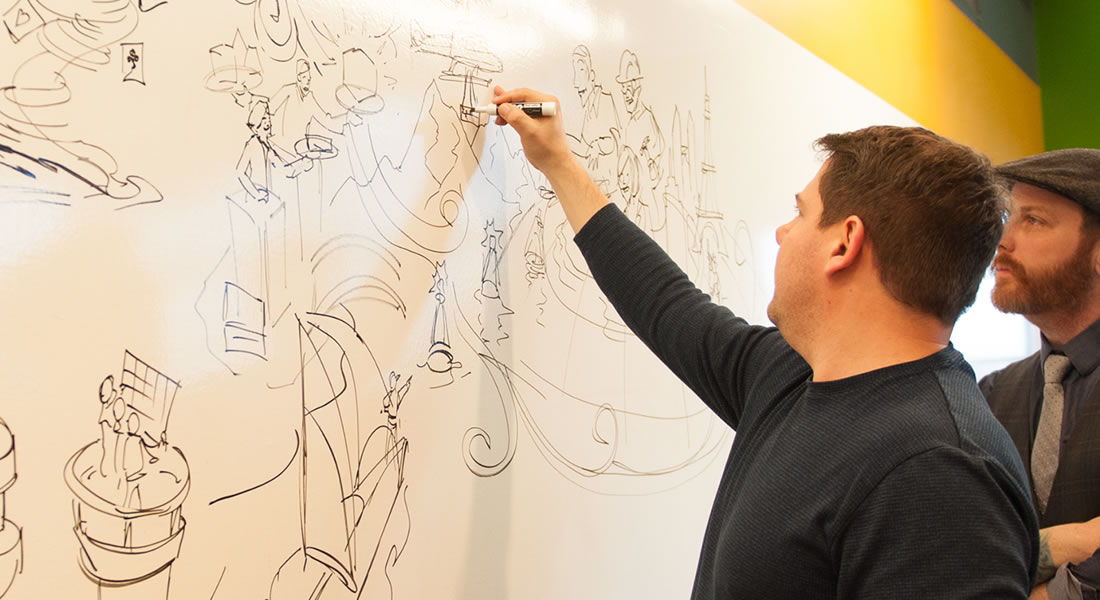Imagine how your company would look and perform if every single person at every level really understood why your company needs to change, what most needs to change and how they contribute to “us” winning. Think it is impossible to truly engage all of your employees in the big picture so they can work together to help your business succeed? Think again!
What if:
- Every person in your organization understood the big picture and was engaged in it, including the economic, technological, competitive and market realities of your business?
- All of your people had an understanding of your strategy far more focused and meaningful than murky visions and missions?
- They understood your organization’s core competencies, knowing exactly what skills would be required to achieve your strategy for the future?
- Everyone realized how slim your margins are and how each person could help them grow?
- They recognized where your money comes from, how difficult it is to make and what is really involved in creating sustainable, profitable growth?
- Your people realized it was imperative to innovate?
- Your organization went beyond the current rhetoric of customer service and deeply explored the hard realities of customer value?
- They really understood the need for a shareholder return in a ferociously competitive world, where stockholders have many other investment alternatives?
- Your people discovered that all customers are not alike?
- Your organization went beyond the “blue sky” rhetoric of internal mandating slogans to true engagement that captures the hearts and minds of your people?
Many may scoff at the idea that it’s possible to get every person in the organization to understand everything it takes to run a successful business. It’s not only possible; it should be the norm for every organization. Yes, getting your people engaged in the big picture is a must!

Getting Employees Engaged in the Big Picture
When employees don’t really have a grasp of the direction of the company, it creates a number of other potential challenges—lack of employee engagement, reduced productivity, poor levels of customer services—to name a few.
But, if leaders start taking the time to translate their complex language of strategy into a common language of execution, so people can make better decisions like owners, the results will speak for themselves.
Strategy without execution is meaningless.
Execution without engaged people is impossible.
By creating relevance and telling the stories of the business in a way that makes sense to their people, leaders will begin to successfully engage their people to execute strategy.
So, what challenges are holding companies back from making this a reality? Here’s what is actually going on…a “Grand Canyon” exists between the leaders, who can see what needs to be done but don’t have their hands on the levers of change, and the doers, who have their hands on the levers of change but simply can’t see the big picture.
Leaders say, “This is our vision.”
Doers reply, “What does this mean for me and my people?”

It’s Time to Bridge the Gap and Help Your People “Get” the Big Picture
The only way to bridge that canyon is to provide everyone with a comprehensive, board-level understanding of the most strategic business issues. For any strategy or change initiative to truly be successful, organizations need to bridge those canyons and help employees feel engaged in the big picture so they can help bring it to fruition.
As organizations set out to bridge their canyons, it’s important to keep these realities in mind:
1. Employees, team members and associates are customers of organizational strategy.
And organizational learning execution speed is not determined by the speed of the brightest individuals, but by the average speed of the entire organization.
2. People will tolerate the directives of leadership, but they will ultimately act on their own.
This is a chilling statement for any company undergoing change. This means no leader can dictate, sell or cajole people across the Grand Canyon. Leaders must set the stage for people to build a bridge and cross it. Leaders must allow people to go on a journey of discovery and draw their own conclusions about critical business issues. Only when people change their conclusions will they change their actions.
3. Everyone in the organization must see and understand the big picture.
They must understand the “why” behind the strategy and/or change. If they are only informed on what they must do, and not the why behind it, the business will not be set up for success.

Visualization Can Help Employee Engagement
Strategic engagement must be approached as a process. In many cases, organizations and leaders treat engagement of people in the strategy as a series of loosely connected events. Roles are not clearly defined and no one seems to truly own strategic engagement.
Some people think human resources or communications owns it; maybe the Chief Financial Officer owns financial results and the Chief Operations Officer owns operational tactics. But if no one owns where all of these critical issues comes together, how can organizations expect their people to see all of the connections and co-dependencies of the elements of strategic engagement? They can’t, so the leadership team must own this process together.
How can organizations help their people quickly understand the most complex business issues? First, people learn visually. Aristotle said, “The soul never thinks without a picture.” Let’s take it one step further: “If a picture is worth a thousand words, a metaphor is worth a thousand pictures.”
Visualization is an accelerant tool. As people absorb new information, it forms a picture in their minds. This picture emerges only when people can create links between their existing knowledge and new information.
Employees tell us they have an “aha”—a moment when they understand, when the picture is complete. Visualizing critical business issues allows individuals, teams and organizations to think in systems, greatly speeding up the “aha” process. It also creates focused thinking, helping everyone build a shared understanding of the larger systems that determine the effectiveness of their individual actions.
If visualization is the first tenet, the second is dialogue—specifically, strategically directed Socratic dialogue. Socrates recognized that learning and change are a matter of asking the right questions, not simply giving the right answers. He developed a system of asking his students questions to get to core truths. He avoided presenting his own conclusions; instead, he sought to immerse learners in exploration and inquiry.

Understanding the Big Picture Leads to Successful Strategy Execution
Business and strategy literacy are essential to make people effective players who know how to keep score on the results. People must have an understanding of how a business operates—leaders, you must engage employees in the big picture—and what it takes to win if they are to participate successfully in improving it.






